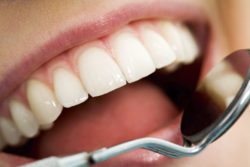

Even if you’re already flossing twice daily as recommended by dentists worldwide, you may not be doing enough to counter the threat of tooth decay and gum disease. Although brushing is an integral part of your oral hygiene regimen, flossing regularly is just as important. Brushing can only remove the plaque-forming particles and the bacteria feeding on them that are easiest to reach.
These most harmless bacteria feed on the plaque, releasing digestive acids that will also break down your tooth enamel. If allowed to continue, this process will eventually cause cavities — holes in your tooth enamel that cause sensitivity and allow bacteria inside which can lead to infection. The most vulnerable spots are between teeth and just below the gum line where it is difficult to brush effectively.
Dr. Vernon Sheen, an experienced and professional dentist located in Annapolis, MD would like to take a few moments to educate his patients on the benefits of flossing.
Why Is Flossing So Important?
There is an old saying that tells us that “an ounce of prevention is worth a pound of cure.” When it comes to tooth decay and gum disease, flossing is that ounce of prevention, helping you to avoid painful, time-consuming and potentially costly dental procedures. However, if you’re going to floss, it is important to floss correctly to get the maximum benefit.
How to Floss Correctly
1. Wrap a length of floss about eighteen inches long around your fingers. Use your thumbs and forefingers to move the floss between your teeth. You should wind more around one finger than the other so you can access a fresh length of floss as you go.
2. Push the floss between two teeth and use a gentle back and forth motion all the way from the top of the teeth down to their base where they emerge from your gums.
3. Wrap the floss around the side of one tooth in a “U” shape and then proceed to gently slide up and down your tooth. Repeat this several times, making sure to go slightly underneath the gum-line, then repeat on the opposite side of the tooth before doing the same to each tooth.
4. You may see that your gums are bleeding from flossing. If you haven’t been flossing regularly, this is perfectly normal. This bleeding due to inflammation of the gum tissue from the bacteria dwelling there. If you begin flossing daily as recommended by your dentist, you will notice an improvement in the health of gums in one to two weeks.
Floss Picks Are Less Effective Than You Think
Many people prefer to use the floss picks that are now widely available at most drug stores. These “Y” shaped pieces of plastic with floss strung between the “arms” of the “Y” are designed to make flossing easier for consumers. However, most dentists would prefer their patients use a length of “free” floss and their hands. Floss picks aren’t able to wrap around a tooth in the “U” shape recommended so you won’t truly be able to floss properly with them, however, it’s still better than not flossing at all.
Schedule An Appointment With Your Dentist
Dr. Sheen and most dentists agree that you should floss after you brush to reduce the amount of plaque that the flossing will need to remove. If you have any additional questions about brushing, flossing or your oral health, call (443) 482- 5202 or schedule an appointment online with Dr. Sheen in Annapolis, MD today.
